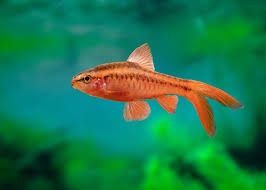Longfin Cherry Barb
R50.00
In stock
Save this product for later
Longfin Cherry Barb
Product Details
Cherry Barbs (scientific name: Puntius titteya) are peaceful and colorful freshwater fish that are relatively easy to care for, making them an excellent choice for beginner to intermediate aquarists. Here’s a comprehensive care guide for Cherry Barbs:
1. Tank Size:
- Minimum size: 40 liters (10 gallons).
- While Cherry Barbs can technically survive in smaller tanks, a 40-liter (10-gallon) tank will allow them to thrive and swim freely.
2. Water Parameters:
- Temperature: 22-28°C (72-82°F).
- pH: 6.0 - 7.5 (slightly acidic to neutral).
- Hardness: 5-15 dGH (soft to moderately hard water).
- Cherry Barbs are relatively adaptable but do best in stable water conditions, so it’s essential to monitor and maintain their tank’s parameters.
3. Tank Setup:
- Substrate: Smooth gravel or sand works well. Cherry Barbs are not bottom dwellers but will occasionally sift through the substrate.
- Plants: Cherry Barbs enjoy plants for hiding and exploring. Live plants like Java Moss, Anubias, Java Fern, and Amazon Sword are ideal.
- Decor: Provide hiding spots with driftwood or rocks to create a natural environment. They also enjoy having some open swimming space.
- Water Movement: Cherry Barbs are peaceful fish and prefer low to moderate water flow, so a gentle filter or sponge filter is ideal.
4. Tankmates:
- Peaceful tankmates: Cherry Barbs are social and non-aggressive, so they are ideal for a community tank. They do well with other peaceful species such as:
- Tetras (e.g., Neon Tetras, Rummy Nose Tetras)
- Corydoras Catfish
- Rasboras
- Guppies
- Otocinclus
- Avoid: Aggressive fish or species with fin-nipping tendencies, such as some types of Barbs or Cichlids.
- Schooling: Cherry Barbs are best kept in groups of at least 5-6 individuals. A small school will help them feel secure and reduce stress.
5. Diet:
- Omnivorous: Cherry Barbs will eat a variety of foods.
- High-quality flake or pellet food designed for tropical fish should be the base of their diet.
- Supplement with live or frozen foods such as brine shrimp, bloodworms, and daphnia.
- Vegetable matter: Cherry Barbs will also benefit from occasional vegetable offerings, like blanched spinach or zucchini.
- They are not picky eaters and will usually graze on algae or detritus in the tank as well.
6. Behavior and Social Needs:
- Peaceful nature: Cherry Barbs are calm, active fish that enjoy swimming in the middle and top areas of the tank. They are not territorial and typically don’t bother other fish.
- Social: They are schooling fish and will feel more secure in groups. While they can be kept individually, they thrive in groups of at least 5-6 individuals, with males often displaying more vibrant coloration, especially during breeding.
- Activity: Cherry Barbs are active and playful, often darting around the tank in a peaceful manner. Watching them swim through plants or explore the tank is a joy.
7. Breeding:
- Breeding setup: Cherry Barbs are egg layers, and breeding is not overly difficult in a well-maintained tank. To encourage breeding, you can separate males and females into a breeding tank with lots of plants and dim lighting.
- Spawning behavior: Males will display their brightest colors to attract females. After mating, the female will lay eggs on plants or substrate. After spawning, it’s best to remove the adult fish, as they might eat the eggs.
- Fry care: The eggs will hatch in about 2-3 days, and the fry will become free-swimming after 5-7 days. Feed them infusoria or powdered fry food until they grow large enough to consume finely crushed flakes.
8. Health and Common Issues:
- Water quality: Maintaining good water quality is crucial. Regular water changes (about 25-30% per week) and a good filtration system will help prevent health issues.
- Fin rot: Cherry Barbs are susceptible to fin rot if the water quality is poor or if they are kept with aggressive tankmates. Keep the water clean and monitor for signs of fin damage.
- Ich (White Spot Disease): If Cherry Barbs are stressed, they may be susceptible to Ich, which presents as white spots on their skin. Treat with an anti-parasitic medication if necessary.
- Swim bladder disease: Overfeeding can lead to swim bladder issues, where the fish may have trouble swimming properly. Feed them a varied diet in small amounts to avoid this.
9. Lifespan:
- Cherry Barbs typically live for about 3-5 years with proper care. Keeping them in stable water conditions, maintaining a peaceful environment, and providing a balanced diet can help extend their lifespan.
Quick Summary:
- Tank size: Minimum 40 liters (10 gallons).
- Temperature: 22-28°C (72-82°F).
- pH: 6.0 - 7.5.
- Diet: Omnivorous (flakes, pellets, live/frozen food).
- Tankmates: Peaceful community fish, avoid aggressive species.
- Behavior: Active, peaceful, social schooling fish (prefer groups of 5-6).
- Breeding: Egg layers, require a breeding tank with plants.
- Lifespan: 3-5 years.
Cherry Barbs are a great addition to any peaceful community tank, and with the right care, they can thrive and bring vibrant color to your aquarium!
Display prices in:ZAR

